2023 Job Seeker Survey Report
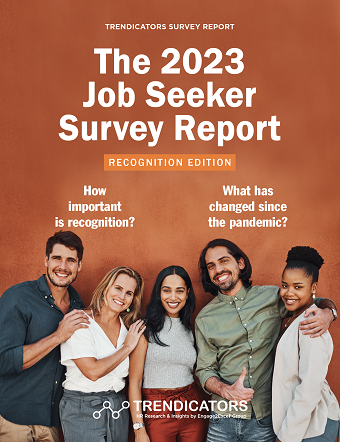
Introduction
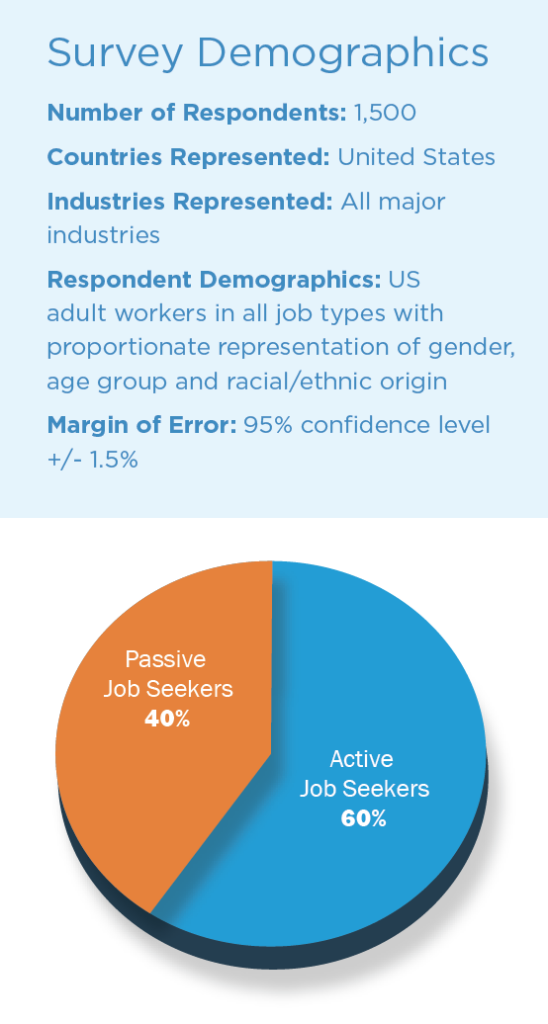 Welcome to the Recognition Edition of the 2023 Job Seeker Survey Report, an analysis of the perceptions and preferences of active and passive candidates across all major industries in the U.S. Produced by Trendicators™, the research division of Engage2Excel Group, this report is based on survey responses from 1,500 job seekers in March 2023. The report reveals insights into key topics to enhance your organization’s hiring, recognition and retention strategies to optimize success.
Welcome to the Recognition Edition of the 2023 Job Seeker Survey Report, an analysis of the perceptions and preferences of active and passive candidates across all major industries in the U.S. Produced by Trendicators™, the research division of Engage2Excel Group, this report is based on survey responses from 1,500 job seekers in March 2023. The report reveals insights into key topics to enhance your organization’s hiring, recognition and retention strategies to optimize success.
- How does recognition during the hiring process influence acceptance or rejection of job offers?
- Why do people seek employment elsewhere?
- How do onboarding experiences affect intent to stay?
- Where does remote work stand?
- How do workers value the demonstration of recognition by employers?
We recently held a roundtable discussion on the results of this survey with members of the Trendicators advisory board. Takeaways and recommendations based on this discussion are included on page 8.

Download
 hbspt.cta.load(123973, '2997141c-d642-4cae-8b44-c051b68269c7', {"useNewLoader":"true","region":"na1"});
hbspt.cta.load(123973, '2997141c-d642-4cae-8b44-c051b68269c7', {"useNewLoader":"true","region":"na1"});
How Does Recognition Influence Job Offer Acceptance or Rejection?
Reasons for Job Offer Acceptance: The pandemic caused unprecedented disruption in the workplace. However, as the survey data below reveals, the top three reasons candidates gave for accepting job offers have remained remarkably constant over the past four years. Being recognized, appreciated and respected throughout the hiring process is most important, followed by fair compensation and job fit. Comparing this year’s survey results with those from 2019, the importance of recognition, appreciation and respect has increased by four percentage points while job fit has dropped 6 points. The workplace has changed significantly, but what candidates want most has not.
Reasons for Job Offer Rejection: In 2023, candidates’ number one reason for rejecting job offers is a lack of recognition, respect and appreciation in the hiring process. This was followed by concerns about compensation and job fit. Over the past four years, the second and third most important reasons for rejecting a job offer have varied between concerns about job security, job fit and compensation.

Download
 hbspt.cta.load(123973, '2997141c-d642-4cae-8b44-c051b68269c7', {"useNewLoader":"true","region":"na1"});
hbspt.cta.load(123973, '2997141c-d642-4cae-8b44-c051b68269c7', {"useNewLoader":"true","region":"na1"});
Why Do People Seek Employment Elsewhere?
In 2023, compensation topped the list of considerations that would cause people to seek employment elsewhere, with 19% of respondents indicating that this was most important. However, lack of recognition, appreciation and respect was a close second this year at 18%, followed by concern over work conditions at 15%.
In 2022, amidst a robust hiring streak, an annual unemployment rate of 3.5% and inflation at 6.5%, lack of recognition, appreciation and respect edged out compensation by one percentage point as the most important attrition driver. Over the past four years, despite significant increases in inflation (‘21–’23) and unemployment rates (‘20–‘23), the top two drivers for voluntary attrition have remained the same.
Attraction vs. Attrition: What candidates have always wanted most when seeking another job opportunity is recognition, respect and appreciation. In 2023, they rated this nine percentage points higher than compensation. However, when it comes to factors that drive employees to consider leaving, compensation and respect are nearly equal in importance. Organizations seeking to attract and retain the best-qualified talent must break down the barriers between recruitment and retention. Creating personal connections in the hiring process and ensuring competitive wages must be followed by getting people into roles where they feel secure, productive and valued.
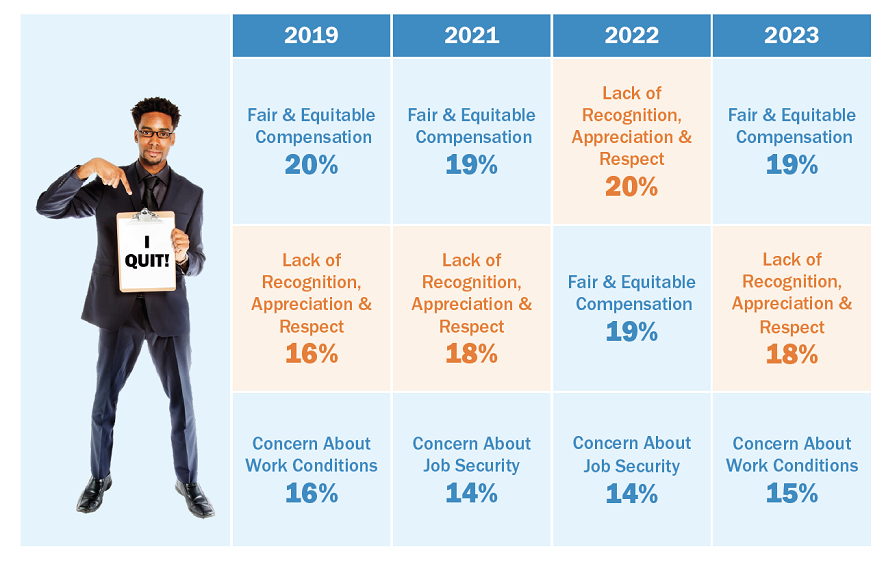
Download
 hbspt.cta.load(123973, '2997141c-d642-4cae-8b44-c051b68269c7', {"useNewLoader":"true","region":"na1"});
hbspt.cta.load(123973, '2997141c-d642-4cae-8b44-c051b68269c7', {"useNewLoader":"true","region":"na1"});
How Do Onboarding Experiences Affect Intent to Stay?
The beginning of any new relationship comes with expectations. Candidates evaluate the quality of the relationship they will have with an employer based on how they are treated in the hiring process. If candidates are not shown the respect they feel they deserve, they are unlikely to accept a job offer. Equally important, if the onboarding process does not align with expectations set during the hiring stage, employees are far more likely to leave. In relationship terms, onboarding can be considered the honeymoon period.
The High Cost of Unfulfilled Expectations: More than two-thirds (70%) of 2023 survey respondents said that the first day of their onboarding experience is Highly Likely or Likely to affect their decision to stay more than a month. Further, 66% said their onboarding experience would affect their decision to stay more than a year. In our recent publication, Improving Retention Rates for New Hires, we reported that the cost of early attrition could range from 16% to 213% of an employee’s annual salary. Creating meaningful onboarding experiences is critical for maximizing your organization’s talent advantage in today’s highly competitive environment.

Download
 hbspt.cta.load(123973, '2997141c-d642-4cae-8b44-c051b68269c7', {"useNewLoader":"true","region":"na1"});
hbspt.cta.load(123973, '2997141c-d642-4cae-8b44-c051b68269c7', {"useNewLoader":"true","region":"na1"});
Where Does Remote Work Stand?
The pandemic had a profound and lasting impact on the advent of remote work. Return-to-office mandates, which once seemed inevitable, are being relaxed to accommodate employee desires for greater flexibility.
Time Spent Working Remotely: More than half (60%) of those surveyed work remotely at least 20% of the time. A significant percentage (46%) work from home between 40% and 100% of the time.
Return to Office Timing: Expectations for when people will return to the office vary, with a majority (60%) expecting to return within the next 3 to 6 months and 20% saying they will not return to the office.
Remote Work Challenges: The most difficult challenges cited in working from home include managing work/life balance (58%), overcoming at-home distractions (37%) and managing mental health issues (21%). Inadequate tools (21%) and insufficient workspace (15%) were among the top challenges.
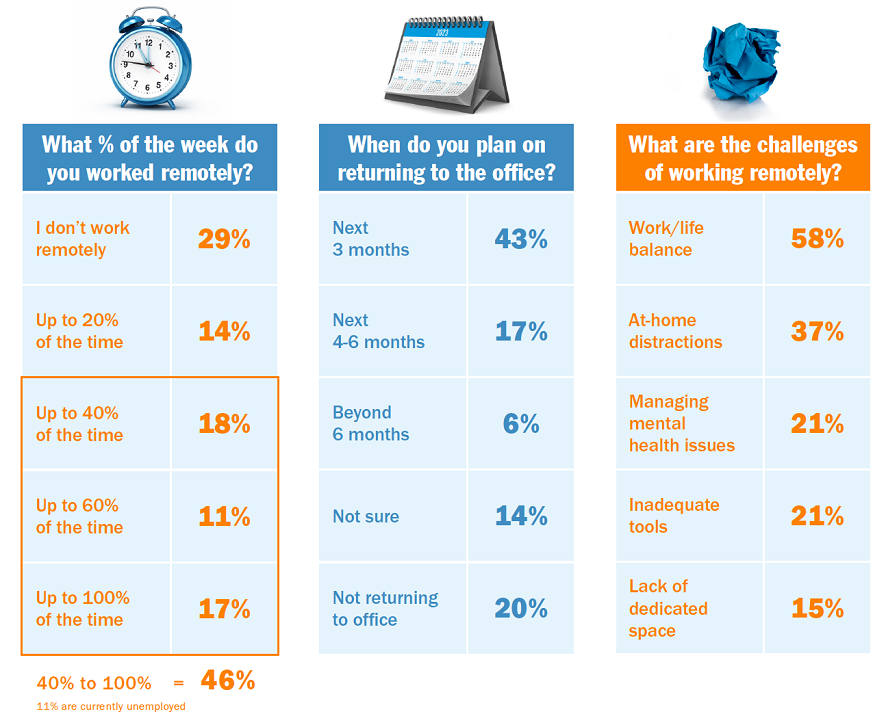
Download
 hbspt.cta.load(123973, '2997141c-d642-4cae-8b44-c051b68269c7', {"useNewLoader":"true","region":"na1"});
hbspt.cta.load(123973, '2997141c-d642-4cae-8b44-c051b68269c7', {"useNewLoader":"true","region":"na1"});
How Do Workers Value the Demonstration of Recognition?
The historical data presented on the previous pages underscore the fact that the demonstration of recognition, appreciation and respect is why people accept or reject job offers and seek employment elsewhere. While the pandemic profoundly affected many aspects of the workplace experience, one thing hasn’t changed. People place a high value on the recognition they receive at work. As many struggle with high inflation, layoffs in the technology and other sectors, remote work policies and uncertainty over social issues, the connections formed at work and the sense of feeling valued by an employer play a vital role in determining emotional well-being, and their willingness to stay.
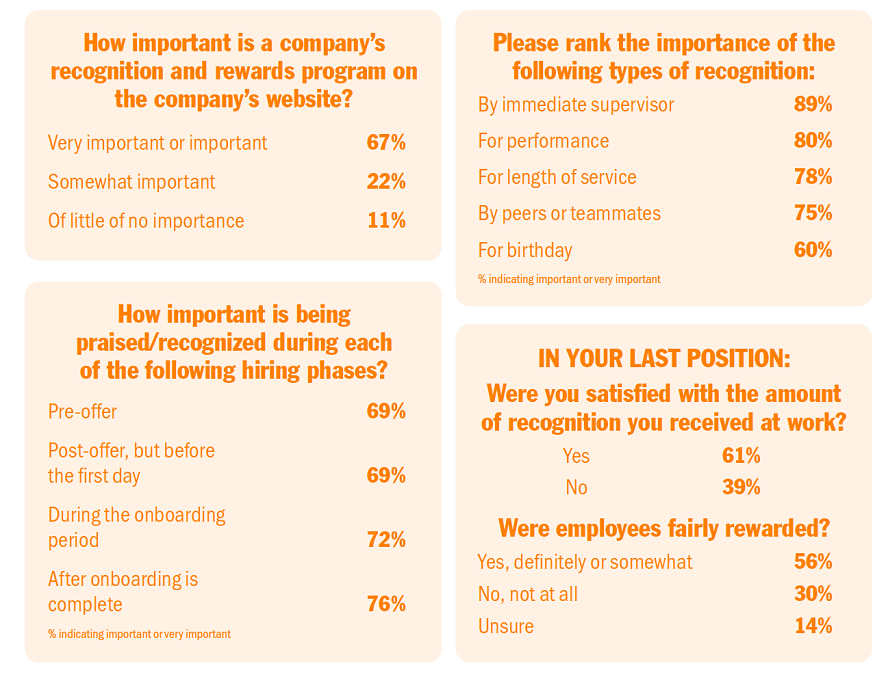
Download
 hbspt.cta.load(123973, '2997141c-d642-4cae-8b44-c051b68269c7', {"useNewLoader":"true","region":"na1"});
hbspt.cta.load(123973, '2997141c-d642-4cae-8b44-c051b68269c7', {"useNewLoader":"true","region":"na1"});
Key Takeaways From the 2023 Job Seeker Survey Report
Two separate roundtable discussions on the results of this survey were held with Trendicators advisory board members responsible for recruitment and recognition programs. The following is a summary of key takeaways and recommendations from those discussions.
The importance of demonstrating recognition, appreciation and respect in the hiring process:
Dr. Jack Wiley, Engage2Excel’s chief scientific officer, joined our discussion with members of the recruitment advisory board in late April. He has been studying employee engagement for more than three decades. Dr. Wiley commented that providing recognition, appreciation and respect during the hiring process creates an emotional connection that is — and always has been — critical for candidates in evaluating job opportunities. If that connection is not made, other considerations will likely not matter. The following are comments on what organizations need to change or do differently to create stronger emotional connections in the hiring process.
The Application Process: We need to reevaluate the degree to which recruiting systems, processes and technologies depersonalize candidate experiences. If an applicant needs to spend 15 minutes setting up an account, creating a password and entering their information only to receive an automated and impersonal response after applying for a job, that is an immediate turn-off. Technology has helped employers become more efficient, but the extent to which recruiting automation solutions have created negative perceptions among candidates is a cause for concern. There has been much discussion in recent years about creating better candidate experiences, but what we need are ways to humanize hiring to create stronger personal connections. HR leaders should apply on their own careers sites to identify opportunities for improvement.
Candidate Engagement: Successful recruiters target individuals whose profiles match open job roles and personally engage with them to learn about their current situation, interests and goals for developing new skills and career advancement. Recruiting is not a sales pitch — it is a discussion. There is no higher form of respect than asking an individual what they seek to achieve in their next position.
Helping Hiring Managers Succeed: We cannot assume that hiring managers know how to effectively engage with high-potential candidates. Managers are distracted and under tremendous pressure to meet deadlines and fill open positions. Whereas some managers possess good candidate engagement and interviewing skills, others need help and training.
Helping Hiring Managers Succeed: We cannot assume that hiring managers know how to effectively engage with high-potential candidates. Managers are distracted and under tremendous pressure to meet deadlines and fill open positions. Whereas some managers possess good candidate engagement and interviewing skills, others need help and training.
Download
 hbspt.cta.load(123973, '2997141c-d642-4cae-8b44-c051b68269c7', {"useNewLoader":"true","region":"na1"});
hbspt.cta.load(123973, '2997141c-d642-4cae-8b44-c051b68269c7', {"useNewLoader":"true","region":"na1"});
The influence of onboarding experiences on voluntary attrition:
We opened our discussions by asking if the importance of the first day and total onboarding experiences was surprising. The answer from both groups was no. The fact that 70% of the respondents said their first day of onboarding would influence their decision to stay for more than a month puts considerable pressure on the quality of that experience. What do organizations need to do differently to address this challenge?
Managing Experiences: The potential for disconnect between what led an individual to join your organization and their onboarding experience is significant. If the personal connection made during recruiting and job acceptance is followed by a poorly planned onboarding process, people naturally question whether they made the right decision.

Celebrating New Hires: Celebrating offer acceptance provides positive affirmation of the decision to join your organization. This can include personal emails from everyone involved in the hiring process saying, “Congratulations. We picked you! We’re so happy that you’ve accepted.” Upon offer acceptance, a personalized, company-branded gift sent to the home provides a physical connection to your organization and demonstrates appreciation to the new hire and their loved ones.
Maximizing Opportunities for Engagement: If the first day of the onboarding experience is simply a matter of filling out paperwork that could have been completed before day one, then there is a high likelihood that this new relationship will start off on the wrong foot. Organizations need to recognize that onboarding is an investment in setting expectations and building a long-term relationship with an individual to help them understand your culture, get to know their co-workers and learn what will be expected of them to succeed as a valued member of your team.
Download
 hbspt.cta.load(123973, '2997141c-d642-4cae-8b44-c051b68269c7', {"useNewLoader":"true","region":"na1"});
hbspt.cta.load(123973, '2997141c-d642-4cae-8b44-c051b68269c7', {"useNewLoader":"true","region":"na1"});
The battle over remote work privileges:
The growing segment of the workforce that wants flexible arrangements for working from home presents both recruiting and retention challenges for all employers. Individuals hired during the pandemic who seek to continue to work remotely can be seen as the ones held to a different standard than those working on-site, presenting an equitability problem. One board member, with high-performing recruiters around the country shared that recruiters inside corporate hubs are saying, “Why do I have to come to the office when my colleagues are sitting at home?”
Back-to-the-Office Backlash: Whereas many of the largest employers, such as Amazon, Apple and Twitter, are hardening demands for workers to return to their cubicles, employee resistance is widespread, and many do not appear to be ready to back down. Several incidents were related where changes in return-to-office policies resulted in increases in turnover and decreases in offer acceptance, particularly from IT staff and knowledge workers.
 Recruiting and Retention Challenges: Ever since the pandemic ushered in new ways of working, many employees have decided that they prefer the flexibility of being able to work from home. A tight labor market has empowered workers to make their demands known. People are leaving for opportunities where they will have more flexibility, presenting recruiting and retention challenges. There are, of course, legitimate reasons for wanting employees back in the office. Proponents say collaboration, mentoring and culture building are better achieved in person. But a significant divide exists between leaders and employers. Several studies report significant increases in performance and productivity related to working remotely, but a highly publicized report from Microsoft last year revealed that three-quarters of leaders surveyed remain skeptical.
Recruiting and Retention Challenges: Ever since the pandemic ushered in new ways of working, many employees have decided that they prefer the flexibility of being able to work from home. A tight labor market has empowered workers to make their demands known. People are leaving for opportunities where they will have more flexibility, presenting recruiting and retention challenges. There are, of course, legitimate reasons for wanting employees back in the office. Proponents say collaboration, mentoring and culture building are better achieved in person. But a significant divide exists between leaders and employers. Several studies report significant increases in performance and productivity related to working remotely, but a highly publicized report from Microsoft last year revealed that three-quarters of leaders surveyed remain skeptical.
No Silver Bullet Solution: The battle over remote work can be expected to continue for many months, if not years. The recent banking crisis, high inflation and recent mass layoffs are a setback for employees, but it is yet unclear how this tug of war will turn out, as talent shortages are expected to continue in the coming years.
Download
 hbspt.cta.load(123973, '2997141c-d642-4cae-8b44-c051b68269c7', {"useNewLoader":"true","region":"na1"});
hbspt.cta.load(123973, '2997141c-d642-4cae-8b44-c051b68269c7', {"useNewLoader":"true","region":"na1"});
Helping remote workers overcome challenges:
Managing work-life balance topped the list of remote work challenges cited by survey respondents. Various studies report that remote workers are working significantly longer hours and experiencing higher rates of burnout than office-based personnel. Distractions include attending to the needs of children, dealing with pestering pets, roommates and noisy neighbors. Lack of in-person interaction can lead to mental health problems, including loneliness and isolation. Inadequate tools and workspace were also cited among the challenges of working remotely.
Helping remote workers address these challenges is essential for companies that continue to offer remote work privileges. In hybrid office situations, successful strategies for promoting employee well-being and engagement include programs for mentorship, better training for managers in one-on-one communication skills, improved onboarding experiences for remote workers and tools for building community and collaboration, including non-work communication channels.

Download
 hbspt.cta.load(123973, '2997141c-d642-4cae-8b44-c051b68269c7', {"useNewLoader":"true","region":"na1"});
hbspt.cta.load(123973, '2997141c-d642-4cae-8b44-c051b68269c7', {"useNewLoader":"true","region":"na1"});
Maximizing return on investment (ROI) in recognition programs
The participants in both of our roundtable discussions agreed that there is a need to elevate awareness of the importance of recognition throughout all stages of the employee lifecycle. Facilitating more meaningful personal connections in recruiting, onboarding and everyday career experiences can be challenging, particularly within larger organizations, where different departments are involved with program management.
Promoting Recognition Programs on Your Career Website: More than two-thirds (67%) of survey respondents said that learning about recognition and rewards programs on an organization’s career website was either important or very important. If your company isn’t highlighting its recognition and rewards program as part of its employer branding strategy, you’re missing out on an important differentiation opportunity to attract top talent.
Delivering Meaningful Recognition Experiences: Survey respondents valued recognition by their immediate supervisor most (89%), followed by recognition by their peers (75%). When it comes to types of recognition, 80% rated recognition for performance as important and very important. Recognition for length of service was also highly rated by 78%, and 60% said they valued being recognized on their birthday.
With these preferences in mind, it pays to investigate the extent to which recognition influences attrition. One board member reported that their organization’s overall turnover rate last year was 22%. However, in stark contrast, the turnover rate for teammates who received recognition was only 1.7%. Consider conducting a similar ROI analysis of the correlation between your organization’s recognition and retention rates when developing your recognition program and budget recommendations for the coming year.
Educating Retention Stakeholders: High employee turnover negatively impacts productivity, engagement and customer satisfaction. But many companies do not have a specific individual or department responsible for employee retention. According to career intelligence firm Zippia, there are eight times more customer retention specialists (309,162) than employee retention specialists (36,730) employed in the U.S. If your organization lacks a single point of accountability for improving retention, educating your recruiting and onboarding stakeholders about the influence of employee recognition on job acceptance and turnover is vital for maximizing your ROI from recognition.

Download
 hbspt.cta.load(123973, '2997141c-d642-4cae-8b44-c051b68269c7', {"useNewLoader":"true","region":"na1"});
hbspt.cta.load(123973, '2997141c-d642-4cae-8b44-c051b68269c7', {"useNewLoader":"true","region":"na1"});